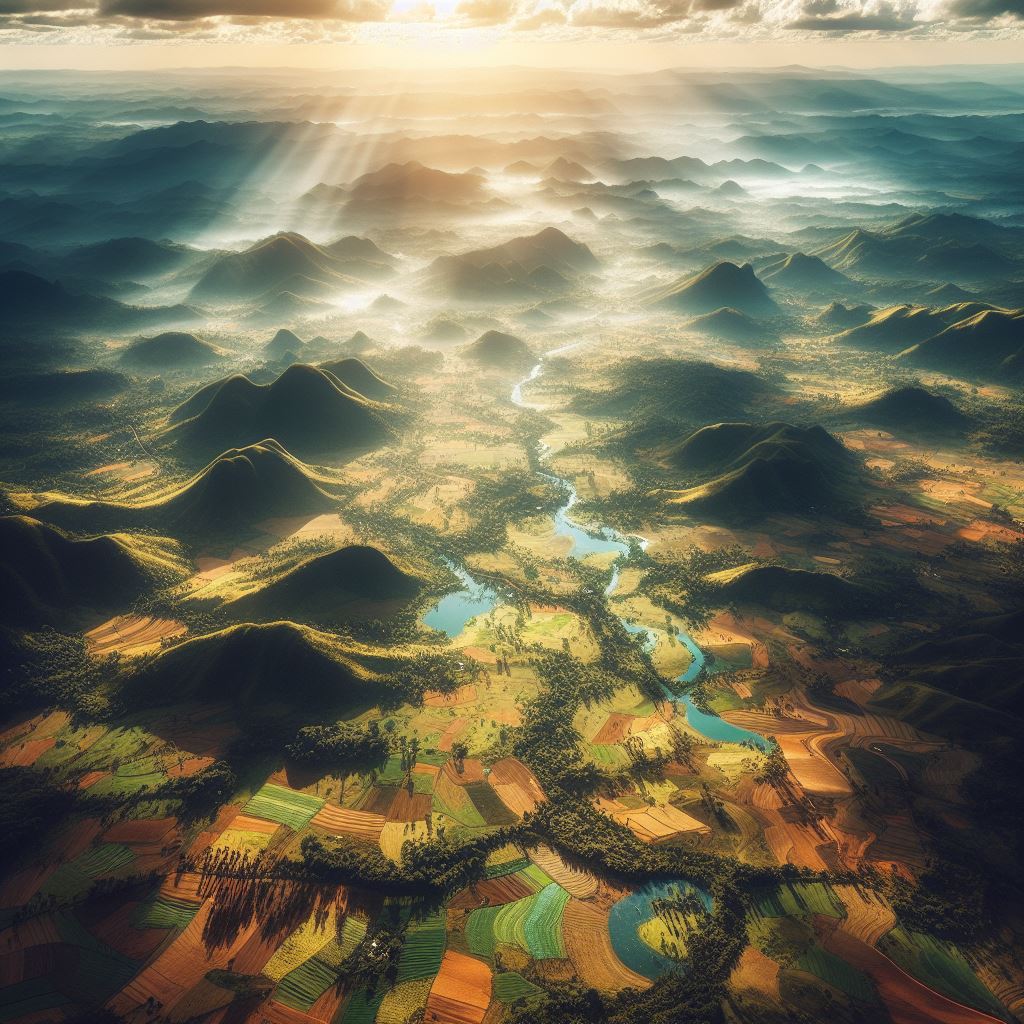April 08, 2023
Africa is a continent of incredible beauty, from its vast deserts to its lush forests and waterfalls. African landscape paintings capture the essence of this vast and varied continent, portraying its rich and diverse landscapes, from sweeping savannahs to lush rainforests, from towering mountains to serene rivers, and from vibrant deserts to pristine beaches. These paintings not only depict the physical beauty of Africa but also convey the cultural, historical, and emotional connections that Africans have with their land. Through their artistic interpretations, African landscape paintings showcase the unique and captivating beauty of Africa in all its glory.
The natural landscapes of Africa have been an inspiration to artists for centuries, and African landscape paintings have been created in a variety of styles and media. These paintings have not only captured the beauty of Africa's landscapes but have also reflected the cultures, histories, and experiences of the artists who created them. In this essay, we will explore the ways in which African landscape paintings have portrayed the natural beauty of the continent.
One of the most striking features of African landscape paintings is their diversity. The landscapes of Africa are incredibly varied, and African artists have used a variety of styles and techniques to capture the different moods and textures of these landscapes. Some artists have used vivid colors and bold brushstrokes to portray the bright, sun-drenched plains of the Serengeti or the bright blue waters of the Indian Ocean. Others have used more subtle colors and delicate brushstrokes to depict the soft, misty light of a morning in the mountains or the gentle, rustling movement of the grasslands. From the stark, geometric forms of the Sahara to the wild, tangled vines of the Congo rainforest, African landscape paintings capture the full range of the continent's natural beauty.
One of the most notable features of African landscape paintings is their use of color. The vibrant, saturated colors of many African landscapes have been a source of inspiration for artists for centuries. In the savannahs and grasslands of East Africa, the bright yellows and oranges of the sun-baked earth contrast with the deep blues of the sky, creating a dynamic, energetic visual effect. Similarly, the lush greens of the Congo rainforest or the rich reds of the Namib Desert create a sense of intense, organic vitality. African landscape painters have used color to convey a sense of place, mood, and atmosphere, capturing the unique spirit of each location.
Another important element of African landscape paintings is their use of light and shadow. Light is a powerful force in African landscapes, creating dramatic contrasts between bright sunlit areas and deep, mysterious shadows. The intense, sharp-edged shadows of the African sun can create a sense of drama and tension, while the soft, diffuse light of dawn or dusk can evoke a sense of peace and tranquility. Many African landscape painters have used light and shadow to create a sense of depth and dimensionality in their work, capturing the way that light interacts with the different textures and surfaces of the landscape.
In addition to capturing the natural beauty of African landscapes, many African landscape paintings also reflect the cultural and historical contexts in which they were created. Many African artists have used landscape paintings as a way of expressing their relationship to the land and the environment. For example, the Ndebele people of South Africa have a long tradition of creating colorful, geometric murals that reflect their connection to the land and the natural world. Similarly, the Maasai people of East Africa have created vibrant paintings that depict the wildlife and landscapes of their traditional homelands. These paintings often reflect the cultural and spiritual values of the communities that create them, conveying a sense of connection to the land and the natural world.
Finally, African landscape paintings often reflect the experiences and perspectives of the artists who create them. Many African artists have used landscape paintings as a way of exploring their own identity and sense of place in the world. For example, the Ghanaian artist El Anatsui creates complex, layered landscapes that reflect his own experiences of migration and displacement. Similarly, the Nigerian painter Ben Enwonwu used landscape paintings to explore the tension between tradition and modernity in African culture.
By depicting the changing landscapes of Africa, Enwonwu was able to explore the complex and often conflicting forces that shape the continent's cultural identity. Through their art, African landscape painters have been able to express their own unique perspectives and experiences, creating a rich and diverse body of work that reflects the many different voices of the continent.
Moreover, African landscape paintings have not only been appreciated for their aesthetic value but have also been used as a tool for education and conservation. Many African countries are home to diverse wildlife and natural habitats, which are often under threat due to human activities. Landscape paintings have been used to raise awareness about the need for conservation and the importance of preserving these natural resources. They have also been used to educate people about the different species and ecosystems found in Africa, fostering a greater appreciation and understanding of the continent's natural heritage.
Additionally, African landscape paintings have also served as a source of inspiration for other artists around the world.
Moreover, African landscape paintings have also influenced contemporary African diaspora artists who draw on their African heritage and cultural roots. These artists often incorporate African landscape motifs and imagery into their works, celebrating their African identity and paying homage to their ancestral land.
In addition, African landscape paintings have also served as a source of inspiration for tourists and travelers visiting Africa. These artworks capture the essence of Africa's landscapes and serve as a reminder of the beauty and wonder of the continent. Many tourists and travelers are drawn to Africa's landscapes through the lens of these paintings, seeking to experience the real-life landscapes that have been immortalized on canvas.
African landscape paintings have also contributed to the promotion of African tourism and conservation efforts. These artworks showcase the unique and fragile beauty of Africa's landscapes, raising awareness about the need to protect and preserve Africa's natural heritage. African landscape paintings have been used in various conservation campaigns and initiatives to promote sustainable tourism and environmental conservation, highlighting the intrinsic value of Africa's landscapes beyond their aesthetic appeal.
Furthermore, African landscape paintings have played a significant role in fostering cultural exchange and understanding between Africa and the rest of the world. These artworks offer a glimpse into African culture, traditions, and way of life, allowing people from different cultural backgrounds to connect with Africa on a deeper level. African landscape paintings serve as a visual representation of Africa's diversity, history, and spirituality, fostering dialogue and appreciation for African art and culture across borders.
The unique blend of colors, textures, and shapes found in African landscapes has influenced the work of artists in various fields, including photography, sculpture, and design. The vibrant patterns and motifs found in African landscape paintings have also been incorporated into contemporary fashion and home decor, adding a touch of exoticism and cultural richness to everyday objects.
In recent years, there has been a growing interest in African art and culture around the world. This has led to an increase in the demand for African landscape paintings, as people seek to connect with the natural beauty and cultural richness of the continent. Many African artists have gained international recognition for their landscape paintings, and their work has been exhibited in galleries and museums around the world. This has not only provided an opportunity for African artists to showcase their talent and creativity but has also helped to promote a more diverse and inclusive art world.
In conclusion, African landscape paintings are a powerful and evocative form of art that captures the natural beauty of the continent. From the vivid colors and bold brushstrokes of the savannahs to the subtle, delicate hues of the mountain forests, African landscape painters have used a variety of styles and techniques to capture the full range of the continent's natural beauty. But African landscape paintings are more than just depictions of the physical world. They also reflect the cultural, historical, and personal contexts in which they were created, conveying a sense of the complex and multifaceted nature of African identity. Through their art, African landscape painters have created a rich and diverse body of work that celebrates the natural world while also exploring the complex relationship between humans and the environment.
As a testament to the enduring appeal of African landscape paintings, many of these artworks can be found on our website, www.tingatingaart.com. Our collection features a wide range of African landscape paintings that showcase the diverse beauty of Africa's landscapes, from the vast savannahs of the Serengeti to the lush rainforests of Congo, the majestic mountains of Kilimanjaro to the serene water bodies of the Nile River. These vibrant and captivating artworks, created by talented African artists, capture the essence of Africa's landscapes, depicting the richness of its flora and fauna, the warmth of its people, and the depth of its cultural heritage. Our website serves as a platform for promoting African art and culture, and these landscape paintings are a testament to the enduring inspiration that Africa's landscapes provide to artists and art enthusiasts worldwide.


